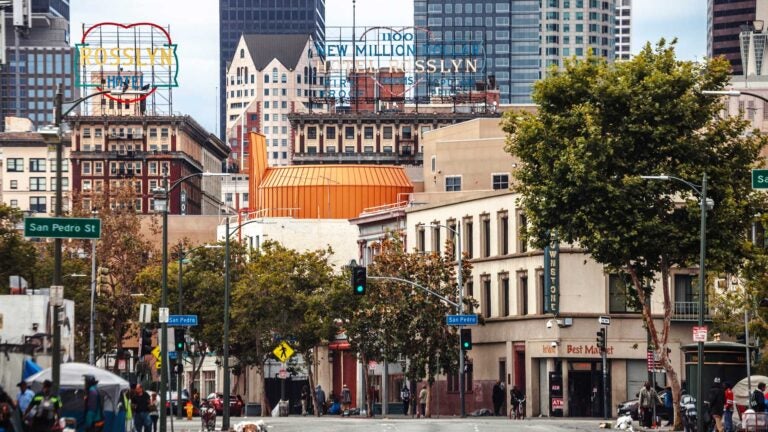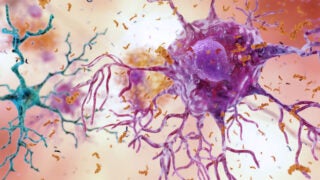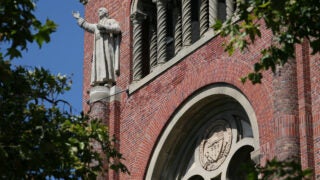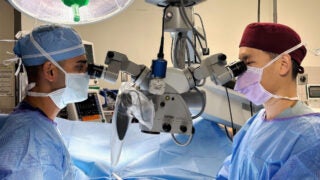
Reporting on the large population of homeless people in Los Angeles gave USC Annenberg students a chance to work on an important subject. (Photo/iStock)
USC Annenberg students capture the human experience on L.A.’s Skid Row
Trojans examine local, state and federal policies that affect the housing, health, income and safety of the city’s homeless
The sprawling community of Skid Row comprises 50 blocks — an epicenter of homelessness. According to the Los Angeles Homeless Services Authority, there are currently 57,794 homeless in Los Angeles County — 4,633 alone along Skid Row. The problem is at the center of a USC initiative to educate and find innovative ways to address homelessness.
Two faculty members at the USC Annenberg School for Communication and Journalism created “Reporting on Homelessness,” a multimedia course that gives students the chance to report accurately and sensitively on the human experience of living on the streets.
“All the students have had completely different ideas about what they want to cover,” said Mary Murphy, senior lecturer of journalism. “One group is covering homeless artists. Another is focusing on how women are treated on Skid Row and a third is concerned with LGBT youth.”
Murphy and USC Annenberg Professor Sandy Tolan designed the class to investigate homelessness and to examine the city, state and federal policies and laws that directly affect the housing, health, income and safety of L.A.’s homeless population. Throughout the semester, the students generate a series of stories across a range of media platforms.
As part of the class, the students also organized a panel discussion last month at The Midnight Mission that included activists, law enforcers, city council representatives and homeless living in the area.
A teachable moment
As Murphy and the students drove toward the mission downtown, she used the journey as a teaching moment, pointing to murals, bubble and block-style graffiti and artwork on once gray walls but now, she noted, full of color and urban storytelling.
“Look around,” Murphy said. “Local businesses and residents are being pushed out of their own neighborhoods.”
She also directed students’ attention to the new commercial spaces opening in a once dilapidated area of downtown.
Where is there room for the homeless?
Mary Murphy
“Where is there room for the homeless?” Murphy asked her students, knowing there was no simple answer.
Murphy and Tolan think it is imperative to vocalize the needs of homeless people, but also to examine the root of the problem through a journalistic approach.
The panel discussion, Tolan said, “is an opportunity for the students to engage directly with the Skid Row community and tie the discussion into their reporting and projects.”
Diagnosing the problems
In the main dining hall at the Midnight Mission, the site of the discussion, activist Jody David Armour, Roy P. Crocker Professor of Law at the USC Gould School of Law, spoke to a packed room. He emphasized the gravity of homelessness and approached it from a macro-level.
If we are going to have a solution, it is going to have to be tailored to a problem and the right problem.
Jody David Armour
“If we are going to have a solution, it is going to have to be tailored to a problem and the right problem. If you have the problems diagnosed incorrectly, the solutions are going to be counter-productive and self-defeating,” he said. “That means sustainable health care, affordable housing and policy change.”
Deon Joseph, a senior lead officer for the Los Angeles Police Department, Central Division, who has been working for more than 18 years on Skid Row, compared the conditions on Skid Row to the 1990s.
“In ’97, it was like Dante’s Inferno. There was human trafficking, gang members brutalizing and victimizing homeless. Disease had spread and drug sales were rampant. There was lawlessness,” Joseph said.
Now conditions are worsening and crime is increasing — Joseph recounted about 20 violent crimes a week, including aggravated assaults. For Murphy, this underscores the need to report on homelessness from all angles.
Students’ thoughts
Razzan Nakhlawi, a senior majoring in journalism, found homelessness to be one of the most visible things she noticed when she moved to Los Angeles from the United Kingdom.
“It is important to talk about U.S.-centric, on-the-ground issues that are happening locally,” Nakhlawi said.
Her research revolves around the $1.2-billion-dollar bond funded for nonprofit developers to erect buildings for those in need.
“I want to make sure policymakers are being held accountable,” Nakhlawi said.
Senior journalism major Ashley Vazquez has a personal connection to homelessness.
“I have family members that have been homeless — not in L.A. — but this has always been a topic of interest of mine,” she said.
Vazquez interned last semester at the Inner City Law Center, a nonprofit law firm that helps homeless veterans and also advocates for low-income tenants through its homeless prevention project. It was there that Vazquez became acquainted with Skid Row residents.
“I was really interested in taking this class because as I was working on Skid Row, I saw a lot of reporters who were not covering the issue very humanely,” Vazquez said.
Vazquez recalls seeing news teams going to Skid Row, brashly walking into people’s homes and putting cameras in their faces.
“I didn’t want to do that and the only way not to do that is to get to know them.”
She is focusing her coverage on women on Skid Row who have either been sexually assaulted or harassed — with few services available to them.
“A lot of women are afraid to say anything,” Vazquez said. “Nobody wants to talk about what is happening to them.”
There were, however, several female homeless trauma survivors who spoke at the forum, including Suzette Shaw.
“Many women have been displaced to Skid Row and the numbers continue to grow,” Shaw said. “We are the No. 1 population — single, black and elderly — so I feel there is a cultural competence that is not being addressed.”
“We do not feel safe,” she added, “We need to find a way to feel protected.”



